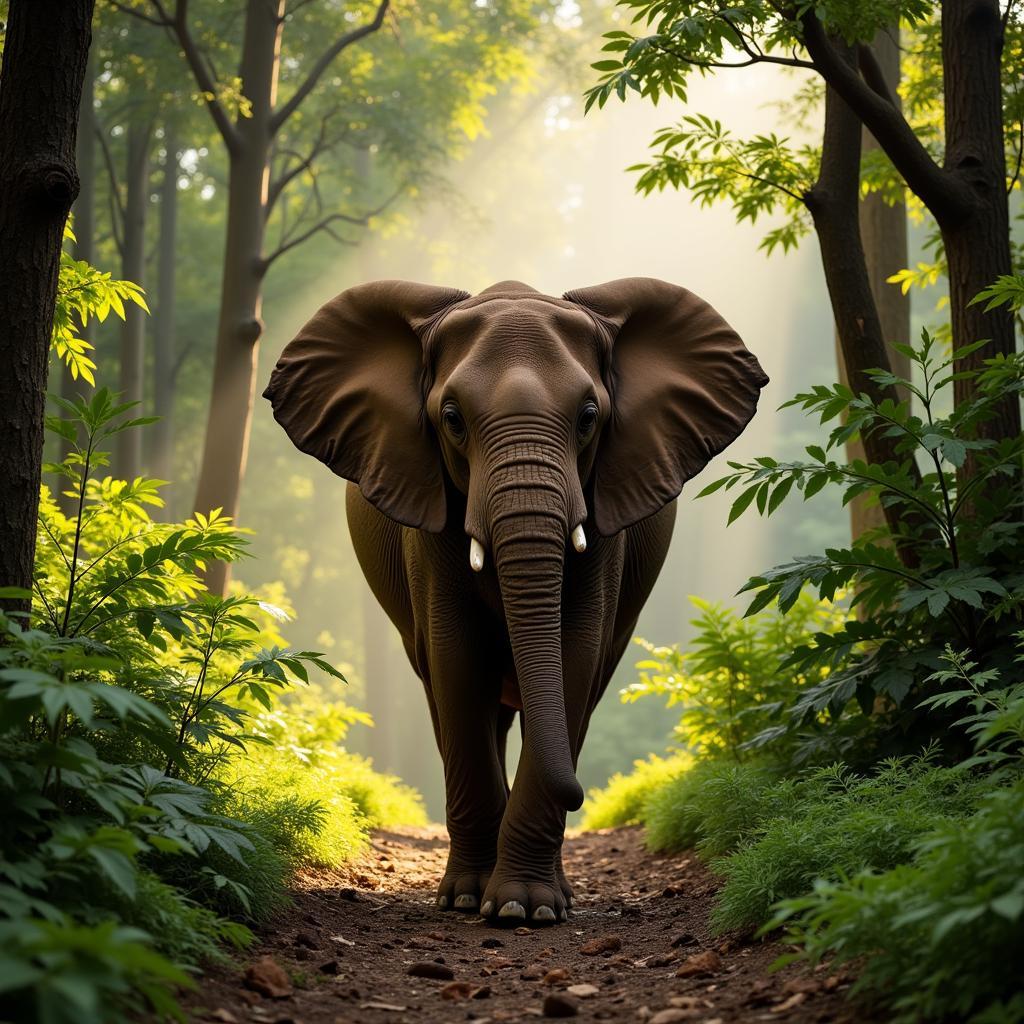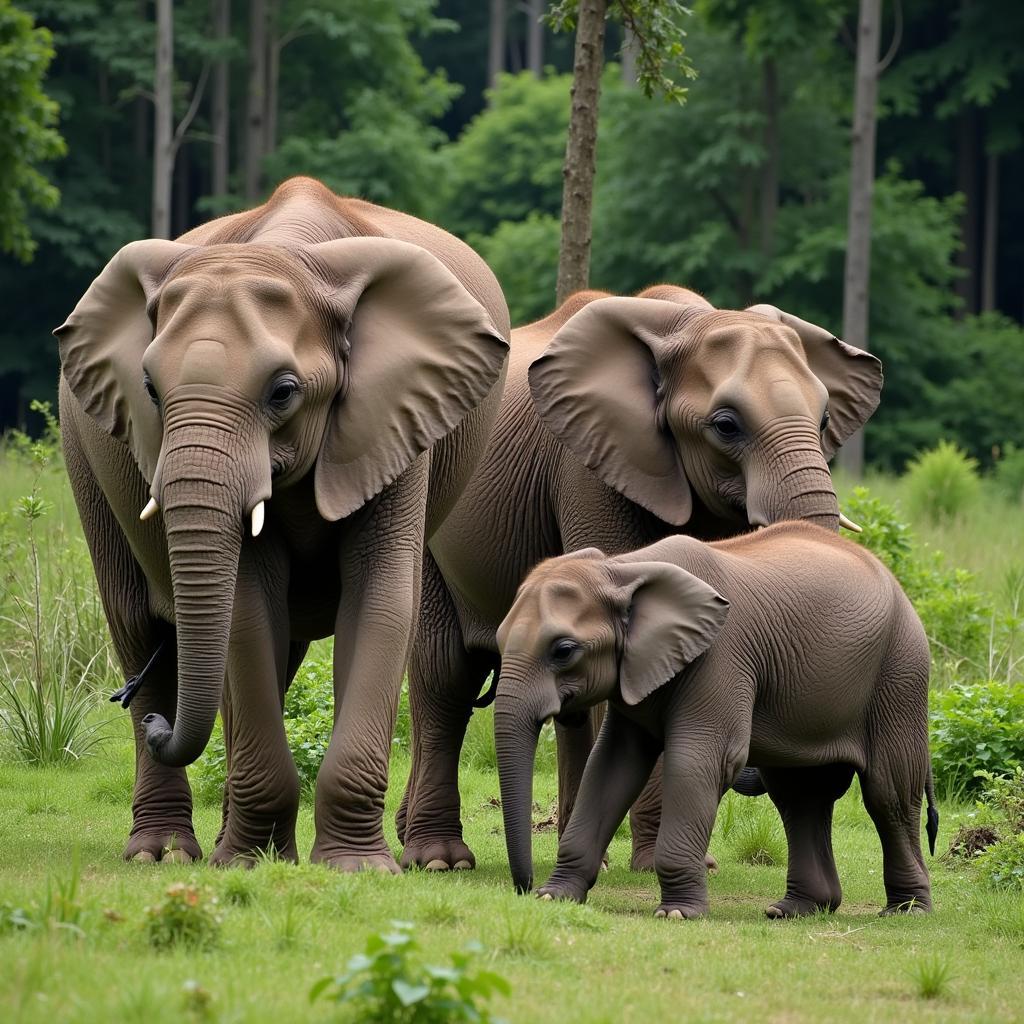African Forest Elephant: A Majestic Giant of the Democratic Republic of Congo
The African forest elephant in the Democratic Republic of Congo (DRC) faces an uncertain future. This article explores the challenges and triumphs in conservation efforts for these magnificent creatures, shedding light on their crucial role within the Congolese rainforest ecosystem. We’ll delve into their unique characteristics, the threats they encounter, and the ongoing initiatives working to secure their survival.
Understanding the African Forest Elephant
The African forest elephant, smaller than its savanna cousin, is uniquely adapted to the dense rainforests of the DRC. They play a vital role in seed dispersal and shaping the forest structure. Their specialized diet, consisting primarily of fruits, leaves, and bark, contributes to the biodiversity of the rainforest. These intelligent giants navigate the dense undergrowth with remarkable agility, creating paths that benefit other forest inhabitants. Understanding their distinct characteristics is crucial for effective conservation strategies. Learn more about where African elephants are located through this resource on African elephant location.
 African forest elephant navigating the dense rainforest in DRC
African forest elephant navigating the dense rainforest in DRC
Threats to the African Forest Elephant in the DRC
Poaching for ivory remains a significant threat to the African forest elephant population. The DRC, with its vast and often inaccessible forests, has become a target for illegal ivory trade. Habitat loss due to deforestation for logging and agriculture also poses a major challenge, shrinking the elephant’s roaming grounds and fragmenting populations. The growing human population and increased demand for resources contribute to this habitat loss, putting immense pressure on the already vulnerable elephant population. Check out the range of African elephants on this map: African elephant range map.
What are the main threats to African forest elephants?
Poaching and habitat loss are the two most significant threats.
Conservation Efforts in the Democratic Republic of Congo
Various organizations and initiatives are dedicated to protecting the African forest elephant in the DRC. These efforts include anti-poaching patrols, community engagement programs, and the establishment of protected areas. Monitoring elephant populations, understanding their movement patterns, and mitigating human-wildlife conflict are key components of these conservation strategies. The DRC government has partnered with international organizations to implement these strategies and strengthen law enforcement to combat illegal wildlife trade. You might also be interested in learning about the African country DR.
The Future of the African Forest Elephant
The future of the African forest elephant in the DRC relies heavily on the success of ongoing and future conservation efforts. Strengthening collaboration between local communities, government agencies, and international organizations is essential for ensuring their long-term survival. Continued research on elephant behavior, ecology, and the impact of human activities is crucial for informing conservation strategies and adapting to evolving challenges. Educating future generations about the importance of wildlife conservation is also paramount in fostering a sense of responsibility and stewardship. See this list for more information on African countries beginning with d.
How can we ensure the survival of the African forest elephant?
Collaborative conservation efforts, ongoing research, and education are key to their survival.
 African forest elephant family group in the DRC rainforest
African forest elephant family group in the DRC rainforest
Conclusion
The African forest elephant in the Democratic Republic of Congo faces a precarious future, but with dedicated conservation efforts, there is hope. Protecting these majestic creatures and their rainforest habitat is not just about preserving biodiversity but also about safeguarding the ecological balance of the region. Supporting ongoing initiatives, raising awareness, and promoting responsible resource management are crucial steps in ensuring that future generations can witness the grandeur of the African forest elephant in the wild. For more related information you can see African countries starting with r.
FAQ
- What is the difference between African forest elephants and African savanna elephants?
- How does the ivory trade affect African forest elephants?
- What are the main challenges in conserving African forest elephants in the DRC?
- How can I contribute to African forest elephant conservation?
- What is the role of the DRC government in protecting these elephants?
- How does the loss of habitat impact African forest elephant populations?
- What is the significance of African forest elephants to the rainforest ecosystem?
Scenarios
- Scenario 1: A researcher wants to study the impact of deforestation on African forest elephant migration patterns.
- Scenario 2: A tourist is interested in visiting a national park in the DRC to see African forest elephants in their natural habitat.
- Scenario 3: A local community member is concerned about increasing human-wildlife conflict with African forest elephants.
Further Exploration
- Read more about the specific conservation initiatives in the DRC.
- Learn about the impact of climate change on African forest elephant habitats.
- Explore the role of technology in monitoring and protecting elephant populations.
Need help? Contact us 24/7: Phone: +255768904061, Email: kaka.mag@gmail.com or visit us at Mbarali DC Mawindi, Kangaga, Tanzania.


